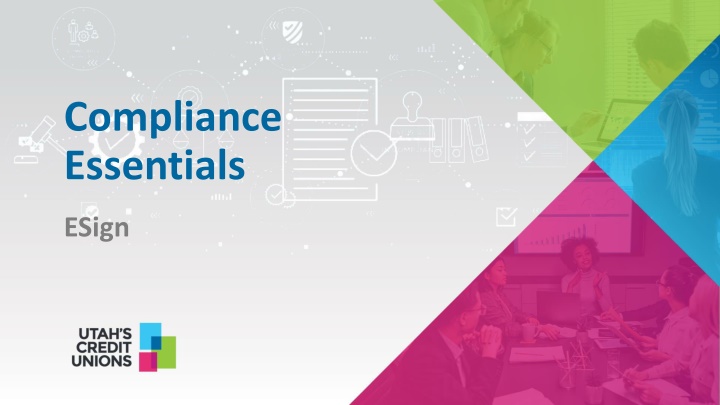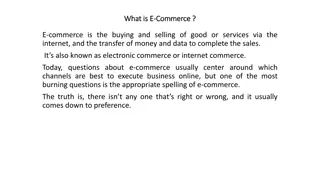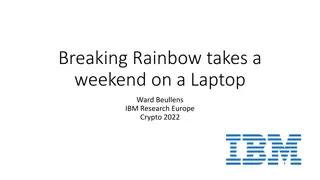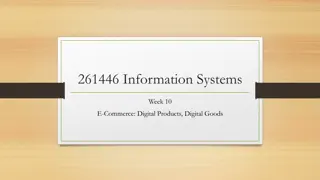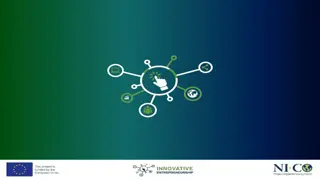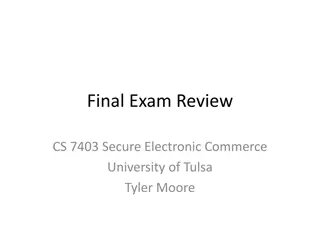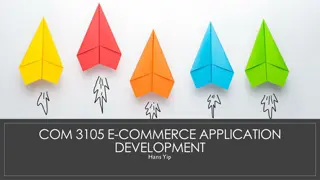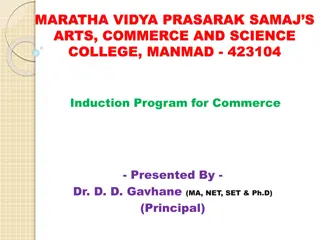Electronic Signatures in Global Commerce
The Electronic Signatures in Global and National Commerce Act of 2000 (ESign) ensures that electronic signatures and records hold the same legal validity as paper records. ESign mandates affirmative consent for electronic transactions and offers flexibility in technology use for e-signatures and records. Learn about definitions, technical requirements, and consumer disclosures in this comprehensive overview.
Download Presentation

Please find below an Image/Link to download the presentation.
The content on the website is provided AS IS for your information and personal use only. It may not be sold, licensed, or shared on other websites without obtaining consent from the author.If you encounter any issues during the download, it is possible that the publisher has removed the file from their server.
You are allowed to download the files provided on this website for personal or commercial use, subject to the condition that they are used lawfully. All files are the property of their respective owners.
The content on the website is provided AS IS for your information and personal use only. It may not be sold, licensed, or shared on other websites without obtaining consent from the author.
E N D
Presentation Transcript
Compliance Essentials ESign
Overview The Electronic Signatures in Global and National Commerce Act of 2000 (ESign) mandates that electronic signatures and records have the same legal validity and enforceability as paper records and handwritten signatures. ESign does not require or recommend the use of any particular technology for electronic records or signatures. Under ESign, members must affirmatively consent or opt in to receive records in electronic form.
Definitions E-Signature An e-signature is an electronic sound, symbol, or process, attached to or associated with a contract or other record that was executed by a person with the intent to sign the record. Electronic Record An electronic record is a contract or other record created, generated, sent, communicated, received, or stored by electronic means.
Technical Requirements ESIGN does not specify any technical requirements for e- signatures or records. Credit unions can use any number of different technologies to facilitate e-contracts with their members, including: Digital signatures that link a person s identity to an encrypted private key issued only to that individual (public key infrastructure or PKI) Biometrics that use a person s unique physical characteristics (such as face, voice and/or fingerprints) for authentication purposes Smart cards credit-card sized plastic cards with an embedded computer chip Oral communication or a recording of an oral communication does not qualify as an electronic record, except as otherwise provided under applicable law.
Consumer Disclosures Three Part Consent Process 1. Before any electronic transaction takes place, the credit union member must first agree to conduct business electronically.
Consumer Disclosures Three Part Consent Process 2. The credit union must then provide members with a clear and conspicuous statement containing the following information: Any right or option the member has to have the record provided or made available on paper or in a non-electronic form The member s right to withdraw their consent Any conditions, consequences, or fees that would result in the event the member withdrew their consent Whether the consent applies only to a particular transaction or to identified categories of records during the lifetime of the member s account relationship The procedures the member must follow to withdraw consent The information the credit union needs in order to contact the member electronically How the member may request a paper copy of an electronic record after consent to receive them electronically has been given Whether a fee will be charged for receiving a paper copy of a record Hardware and software requirements necessary to access and retain electronic records
Consumer Disclosures Three Part Consent Process 3. The member must either send the consent electronically, or confirm the consent electronically in a way that demonstrates that he or she can access information in the electronic form required to successfully conduct the transaction.
Consumer Disclosures Changes in Requirements If at any time there is a change in the hardware or software requirements that creates a material risk the member will not be able to access or retain an electronic record of the transaction, the credit union must provide the member with a statement that includes: The revised hardware and software requirements for access to and retention of the electronic records The member s right to withdraw their consent without the imposition of any fees or conditions that were not originally disclosed.
Record Retention Record Retention An electronic record satisfies the record keeping requirements if the record: Accurately reflects the information contained in the paper contract or other record. Can be accessed by all persons legally entitled to access in a form that can be accurately reproduced for later reference, whether by transmission, printing or otherwise.
Disclosures NOT Subject to Esign REGULATION SECTION DESCRIPTION Self-test disclosure regarding information about race, color, religion, national origin or sex. 12 CFR 1002.5(b)(1) 12 CFR 1002.5(b)(2) Disclosure regarding sex (i.e., the designation of a title is optional). Disclosure regarding marital status information requests (i.e., "A creditor may explain that the category unmarried includes single, divorced, and widowed persons."). Regulation B (only applies when the member is electronically applying for credit) 12 CFR 1002.5(d)(1) Disclosure regarding income from alimony, child support or separate maintenance. 12 CFR 1002.5(d)(2) 12 CFR 1002.13 Government monitoring information disclosure. 12 CFR 1002.14(a)(2) Notice of right to receive appraisal.
Disclosures NOT Subject to Esign REGULATION SECTION DESCRIPTION 12 CFR 1005.20(c)(2) Gift card/gift certificate disclosures. Regulation E Remittance transfer pre-payment disclosure when request is received electronically. 12 CFR 1005.31(b)(1)
Disclosures NOT Subject to Esign REGULATION SECTION DESCRIPTION 12 CFR 1005.20(c)(2) Gift card/gift certificate disclosures. Regulation E Remittance transfer pre-payment disclosure when request is received electronically. 12 CFR 1005.31(b)(1)
Disclosures NOT Subject to Esign REGULATION SECTION DESCRIPTION 12 CFR 1026.16 Open-end credit advertising disclosures for electronic advertisements. 12 CFR 1026.40 Home equity plan disclosures when accompanying an electronic application. Credit and charge card application and solicitation disclosures for electronic application and solicitation. 12 CFR 1026.60 Disclosures to be provided for mail/telephone order that are required to delay closed-end credit disclosures until the due date of the first payment. Does not apply to transactions subject to sections 1026.19(a), (e) or (f). Regulation Z 12 CFR 1026.17(g) Early adjustable rate mortgage disclosures that must be provided at the time an electronic application is provided or before the member pays a non-refundable fee, whichever is earlier. 12 CFR 1026.19(b) 12 CFR 1026.24 Closed-end credit advertising disclosures for electronic advertisements.
Disclosures NOT Subject to Esign REGULATION SECTION DESCRIPTION 12 CFR 707.4(a)(2) Account disclosures requested by members or potential members. NCUA Truth In Savings 12 CFR 707.8 Advertising disclosures for electronic advertisements.
Compliance Cr e ESign
FinCEN Beneficial Ownership Information Reporting
Beneficial Ownership Beginning January 1, 2024, many businesses will be required to report their beneficial owner information (BOI) electronically to FinCEN through its website: www.fincen.gov/boi. We continue to wait for the agency to finalize the BOI Access Rule. The Access rule will describe how credit unions may obtain the BOI from FinCEN s database, and how the information must be protected.
Small Business Data Collection and Reporting Rule
CFPB and its, uh, problems Funding One of the main points of contention is the CFPB's relatively independent structure. Unlike most other federal agencies, the CFPB is not funded through the congressional appropriations process. Instead, it is funded directly by the Federal Reserve, which some critics argue results in limited congressional oversight. This funding arrangement can be seen as undermining the system of checks and balances between the legislative and executive branches.
CFPB and its, uh, problems Single Director Leadership The CFPB is led by a single director who serves a five-year term and can only be removed by the President for cause, such as neglect of duty or malfeasance. This is in contrast to most federal agencies, which have boards or commissions with multiple members. Critics argue that this concentration of power in a single director reduces accountability and makes the bureau less responsive to changes in political leadership.
The CFPB Goes to Court Lower Courts The Community Financial Services Association of America, a trade group for the payday lending industry, filed a lawsuit in 2018 challenging a CFPB rule restricting payday lending. The United States District Court for the Western District of Texas upheld the rule. The CFSAA appealed to the United States Court of Appeals for the Fifth Circuit, which in October 2022 upheld the rule against an Administrative Procedure Act challenge, but held the rule must be vacated because it was created when the agency was funded by the Federal Reserve. The Fifth Circuit held this funding mechanism was unconstitutional.
The CFPB Goes to Court Supreme Court Oral argument was held on October 3, 2023.
The CFPB Goes to Court Lower Courts The Community Financial Services Association of America, a trade group for the payday lending industry, filed a lawsuit in 2018 challenging a CFPB rule restricting payday lending. The United States District Court for the Western District of Texas upheld the rule. The CFSAA appealed to the United States Court of Appeals for the Fifth Circuit, which in October 2022 upheld the rule against an Administrative Procedure Act challenge, but held the rule must be vacated because it was created when the agency was funded by the Federal Reserve. The Fifth Circuit held this funding mechanism was unconstitutional.
The CFPB Goes to Court Another Regulation, Another lawsuit In the Dodd-Frank Wall Street Reform and Consumer Protection Act, Congress directed the Bureau to adopt regulations governing the collection of small business lending data. Section 1071 of the Dodd-Frank Act amended the Equal Credit Opportunity Act (ECOA) to require financial institutions to compile, maintain, and submit to the Bureau certain data on applications for credit for women-owned, minority-owned, and small businesses. Congress enacted section 1071 for the purpose of: Facilitating enforcement of fair lending laws Enabling communities, governmental entities, and creditors to identify business and community development needs and opportunities for women-owned, minority- owned, and small businesses March 2023: The 1071 rule was finalized by the CFPB (data collection to begin in October 2024)
The CFPB Goes to Court Another Regulation, Another lawsuit April 2024: The Texas Bankers Association (TBA), American Bankers Association (ABA) and a small Texas bank sued, saying the CFPB had no authority to issue the rule because an appeals court found the regulator's funding structure unlawful. July 2024: U.S. District Court Judge Randy Crane in McAllen, Texas, granted a preliminary injunction blocking the CFPB from enforcing the rule against members of both groups and McAllen-based Rio Bank. August 2023: The Credit Union National Association (CUNA), the Cornerstone League (representing Texas credit unions), and Rally Credit Union (in Texas) filed a motion to intervene, then a joinder to an emergency motion for preliminary injunction to obtain parity for credit unions. October 26, 2023: The U.S. District Court for the Southern District of Texas issued an order expanding its initial injunctive relief Thursday, meaning the CFPB s 1071 rule is stayed for all financial institutions covered by the rule.
The CFPB Goes to Court What Now? We wait for the Supreme Court s decision regarding the constitutionality of the CFPB s funding. And Then? No More Regulations, right? Not quite. Although the Payday Lending Rule and the Small Business Data Collection Rule may be temporarily delayed, they will both most likely come back under a restructured CFPB. Most regulations credit unions must comply with pre-date the CFPB
Small Business Data Collection and Reporting Rule Background Section 1071 of the Dodd-Frank Act (Section 1071) amended the Equal Credit Opportunity Act (ECOA) to require financial institutions to compile data regarding certain business credit applications and report that data to the CFPB. Section 1071 specifies several data points that financial institutions are required to report and provides authority for the CFPB to require financial institutions to report additional data points that the CFPB determines would aid in fulfilling Section 1071 s purposes.
Small Business Data Collection and Reporting Rule Purposes of Section 1071 Facilitating enforcement of fair lending laws Enabling the identification of business and community development needs and opportunities for women-owned, minority-owned, and small businesses.
Small Business Data Collection and Reporting Rule Institutional Coverage The final rule applies to covered financial institutions. A covered financial institution is an entity that engages in any financial activity, and that originated at least 100 covered originations in each of the two preceding calendar years.
Small Business Data Collection and Reporting Rule Covered Originations Certain Covered Transactions Originated to Small Businesses Small Business The final rule s definition of small business incorporates, in part, the Small Business Administration s (SBA) definition of small business concern. Pursuant to the final rule, a small business is a small business concern that had $5 million or less in gross annual revenue for its preceding fiscal year.
Small Business Data Collection and Reporting Rule Not Considered Small Businesses Non-profit organizations Governmental entities Gross Annual Revenue A financial institution is permitted to rely on an applicant s representations regarding gross annual revenue (which may or may not include affiliate revenue) for purposes of determining small business status. If a financial institution verifies applicant-provided gross annual revenue information or if an applicant provides updated gross annual revenue information, the financial institution must use the verified or updated information to determine small business status.
Small Business Data Collection and Reporting Rule Covered Credit Transaction A covered credit transaction is an extension of business credit under Regulation B. Covered credit transactions can include loans, lines of credit, credit cards, merchant cash advances, and credit products used for agricultural purposes.
Small Business Data Collection and Reporting Rule Not Covered Credit Transactions Trade credit HMDA reportable transactions Insurance premium financing Public utility credit Securities credit Incidental credit
Small Business Data Collection and Reporting Rule Covered Originations For purposes of determining institutional coverage and compliance date tier, financial institutions count covered originations. A covered origination is a covered credit transaction that the financial institution originated to a small business. Refinancings can be covered originations. However, extensions, renewals, and other amendments of existing transactions are not considered covered originations even if they increase the credit line or credit amount of the existing transaction.
Small Business Data Collection and Reporting Rule Compliance date tier Origination threshold for the compliance date tier Date that a covered financial institution begins collecting data and otherwise complying with the final rule Deadline for a covered financial institution to report first year of data to the CFPB Tier 1 At least 2,500 covered originations in both 2022 and 2023 October 1, 2024 June 1, 2025 Tier 2 At least 500 covered originations in both 2022 and 2023 but not 2,500 or more covered originations in both 2022 and 2023 April 1, 2025 June 1, 2026 Tier 3 At least 100 covered originations in both 2022 and 2023 but not 500 or more covered originations in both 2022 and 2023 January 1, 2026 June 1, 2027
Small Business Data Collection and Reporting Rule Counting Originated Loans for Institutional Coverage and Compliance Date Tiers 1. Count all business loan originations including refinances 2. Subtract HMDA reportable loans (and other non-covered credit transactions) 3. Subtract loans made to non-profits and government entities 4. Subtract loans made to businesses with gross annual revenues above $5 million per year
Small Business Data Collection and Reporting Rule Next Steps 1. Determine if your credit union is a covered institution or is close to being a covered institution 2. Determine to which compliance date tier your credit union belongs 3. Read compliance guides on the CFPB website to at least become familiar with what the rule entails 4. Wait
Questions? Heather Line Compliance Specialist heather@utahscreditunions.org 801-599-2168
